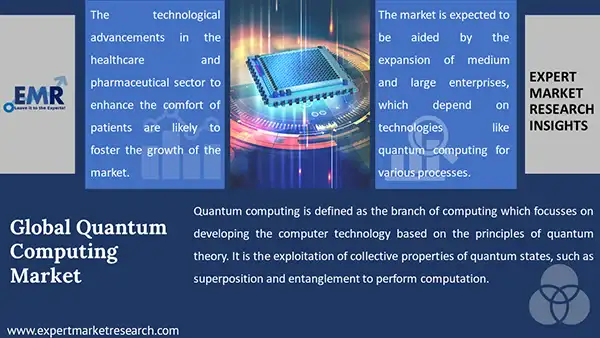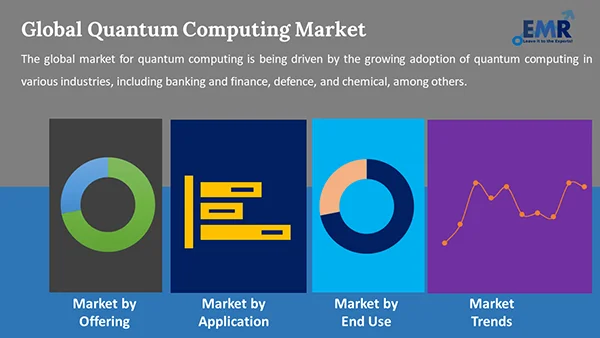
Consumer Insights
Uncover trends and behaviors shaping consumer choices today
Procurement Insights
Optimize your sourcing strategy with key market data
Industry Stats
Stay ahead with the latest trends and market analysis.
The global quantum computing market stood at a value of around USD 1082.40 Million in 2025. The market is further expected to grow at a CAGR of 28.80% in the forecast period of 2026-2035 to attain a value of approximately USD 13600.24 Million by 2035.
Base Year
Historical Period
Forecast Period
Compound Annual Growth Rate
28.8%
Value in USD Million
2026-2035
*this image is indicative*
Based on offering, the services segment is likely to hold a significant share in the market. This can be attributed to the growing adoption of quantum computing as a service (QCaaS) in healthcare and pharmaceuticals, chemicals, defence, and banking, among other sectors. Quantum computer are fast and effective and can perform calculations in seconds. Therefore, they are used extensively for speeding up the processes in these industries, especially BFSI.

Read more about this report - REQUEST FREE SAMPLE COPY IN PDF
Meanwhile, the increasing utilisation of this technology in optimisation, simulation, and machine learning applications in various end use industries to achieve optimum utilisation cost has been aiding the market. Over the forecast period, the expansion of network quantum information technologies (NQIT) is likely to enhance the incorporation of optimisation solutions for resolving problems that come up during the practical applications of quantum computing.
The BFSI, on the basis of end use, accounted for a significant share in the market and is likely to grow at a considerable rate in the forecast period. This growth can be attributed to the early adoption of quantum computing technology in the banking and finance sector due to the potential computational power of quantum computers. In the finance sector, quantum computing is crucial for solving critical problems in areas like cybersecurity to safeguard customers’ financial data. Financial data of customers encoded with quantum cryptography is far more secure than current levels of digital security. This factor is expected to further aid the market growth over the forecast period. Meanwhile, the healthcare and pharmaceutical segment is likely to witness a robust growth in the forecast period owing to the global outbreak of the COVID-19 pandemic. Quantum computing in healthcare bolsters the health plans by accelerating diagnosis, personalising medicine, and optimising prices. It can provide the patients with fast and reliable diagnosis options.
The emergence of small, medium, and large enterprises in the region is likely to propel the demand for quantum computing in the forecast period. The Asia Pacific is a leading hub for several industries like pharmaceuticals, and chemicals, among others. Therefore, the technological advancements in these sectors are expected to foster the demand for quantum computing. The market in the region will further be aided by the expansion of leading technology companies in countries like India and China.

Read more about this report - REQUEST FREE SAMPLE COPY IN PDF
Quantum computing is defined as the branch of computing which focusses on developing the computer technology based on the principles of quantum theory. It is the exploitation of collective properties of quantum states, such as superposition and entanglement to perform computation.
Based on offering, the market is divided into
The significant applications of the product include
The various end uses of the product include
Based on region, the market can be divided into:
The global quantum computing industry is driven by the increasing demand in various end use sectors such as defence, BFSI, and others. The market growth is supported by the rapid technological advancements and the growing reliance of various industries on advanced computing technology to solve complex problems that today's most powerful supercomputers cannot solve. The thriving sectors in emerging economies, including health and pharmaceuticals, chemicals, and energy and power, among others are significantly contributing to the growth of the industry. Over the forecast period, the rising investments by the government in quantum computing technology to develop advanced solutions and expand their knowledge base related to quantum computing are likely to provide further impetus to the market growth.
The report gives a detailed analysis of the following key players in the global quantum computing market, covering their competitive landscape, capacity, and latest developments like mergers, acquisitions, and investments, expansions of capacity, and plant turnarounds:
The comprehensive EMR report provides an in-depth assessment of the market based on the Porter's five forces model along with giving a SWOT analysis.




*While we strive to always give you current and accurate information, the numbers depicted on the website are indicative and may differ from the actual numbers in the main report. At Expert Market Research, we aim to bring you the latest insights and trends in the market. Using our analyses and forecasts, stakeholders can understand the market dynamics, navigate challenges, and capitalize on opportunities to make data-driven strategic decisions.*
Get in touch with us for a customized solution tailored to your unique requirements and save upto 35%!
In 2025, the global quantum computing market attained a value of nearly USD 1082.40 Million.
The market is projected to grow at a CAGR of 28.80% between 2026 and 2035.
The market is estimated to witness a healthy growth in the forecast period of 2026-2035 to reach USD 13600.24 Million by 2035.
The major regions in the industry are North America, Latin America, the Middle East and Africa, Europe, and the Asia Pacific.
System and services are the major types of offerings in the market.
Optimisation, simulation, and machine learning, among others are the significant applications of the product.
Healthcare and pharmaceuticals, chemicals, defence, BFSI, and energy and power, among others are the important end use sectors of the product.
The major players in the industry are Microsoft Corporation, IBM Corporation, Intel Corporation, Google Inc., and D-Wave Systems Inc., among others.
Explore our key highlights of the report and gain a concise overview of key findings, trends, and actionable insights that will empower your strategic decisions.
| REPORT FEATURES | DETAILS |
| Base Year | 2025 |
| Historical Period | 2019-2025 |
| Forecast Period | 2026-2035 |
| Scope of the Report |
Historical and Forecast Trends, Industry Drivers and Constraints, Historical and Forecast Market Analysis by Segment:
|
| Breakup by Offering |
|
| Breakup by Application |
|
| Breakup by End Use |
|
| Breakup by Region |
|
| Market Dynamics |
|
| Competitive Landscape |
|
| Companies Covered |
|
| Report Price and Purchase Option | Explore our purchase options that are best suited to your resources and industry needs. |
| Delivery Format | Delivered as an attached PDF and Excel through email, with an option of receiving an editable PPT, according to the purchase option. |
Datasheet
One User
USD 2,499
USD 2,249
tax inclusive*
Single User License
One User
USD 3,999
USD 3,599
tax inclusive*
Five User License
Five User
USD 4,999
USD 4,249
tax inclusive*
Corporate License
Unlimited Users
USD 5,999
USD 5,099
tax inclusive*
*Please note that the prices mentioned below are starting prices for each bundle type. Kindly contact our team for further details.*
Flash Bundle
Small Business Bundle
Growth Bundle
Enterprise Bundle
*Please note that the prices mentioned below are starting prices for each bundle type. Kindly contact our team for further details.*
Flash Bundle
Number of Reports: 3
20%
tax inclusive*
Small Business Bundle
Number of Reports: 5
25%
tax inclusive*
Growth Bundle
Number of Reports: 8
30%
tax inclusive*
Enterprise Bundle
Number of Reports: 10
35%
tax inclusive*
How To Order

Select License Type
Choose the right license for your needs and access rights.

Click on ‘Buy Now’
Add the report to your cart with one click and proceed to register.

Select Mode of Payment
Choose a payment option for a secure checkout. You will be redirected accordingly.
Gain insights to stay ahead and seize opportunities.

Get insights & trends for a competitive edge.

Track prices with detailed trend reports.

Analyse trade data for supply chain insights.

Leverage cost reports for smart savings

Enhance supply chain with partnerships.

Connect For More Information
Our expert team of analysts will offer full support and resolve any queries regarding the report, before and after the purchase.
Our expert team of analysts will offer full support and resolve any queries regarding the report, before and after the purchase.
We employ meticulous research methods, blending advanced analytics and expert insights to deliver accurate, actionable industry intelligence, staying ahead of competitors.
Our skilled analysts offer unparalleled competitive advantage with detailed insights on current and emerging markets, ensuring your strategic edge.
We offer an in-depth yet simplified presentation of industry insights and analysis to meet your specific requirements effectively.
Share